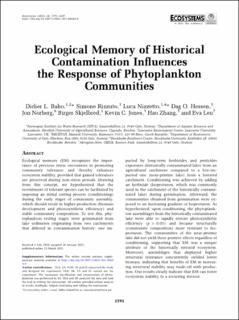| dc.contributor.author | Baho, Didier Ludovic | |
| dc.contributor.author | Rizzuto, Simone | |
| dc.contributor.author | Nizzetto, Luca | |
| dc.contributor.author | Hessen, Dag Olav | |
| dc.contributor.author | Norberg, Jon | |
| dc.contributor.author | Skjelbred, Birger | |
| dc.contributor.author | Jones, Kevin C. | |
| dc.contributor.author | Zhang, Hao | |
| dc.contributor.author | Leu, Eva | |
| dc.date.accessioned | 2022-01-18T12:46:00Z | |
| dc.date.available | 2022-01-18T12:46:00Z | |
| dc.date.created | 2021-12-14T17:47:39Z | |
| dc.date.issued | 2021 | |
| dc.identifier.citation | Ecosystems. 2021, 24 (7), 1591-1607. | en_US |
| dc.identifier.issn | 1432-9840 | |
| dc.identifier.uri | https://hdl.handle.net/11250/2837942 | |
| dc.description.abstract | Ecological memory (EM) recognizes the importance of previous stress encounters in promoting community tolerance and thereby enhances ecosystem stability, provided that gained tolerances are preserved during non-stress periods. Drawing from this concept, we hypothesized that the recruitment of tolerant species can be facilitated by imposing an initial sorting process (conditioning) during the early stages of community assembly, which should result in higher production (biomass development and photosynthetic efficiency) and stable community composition. To test this, phytoplankton resting stages were germinated from lake sediments originating from two catchments that differed in contamination history: one impacted by long-term herbicides and pesticides exposures (historically contaminated lake) from an agricultural catchment compared to a low-impacted one (near-pristine lake) from a forested catchment. Conditioning was achieved by adding an herbicide (Isoproturon, which was commonly used in the catchment of the historically contaminated lake) during germination. Afterward, the communities obtained from germination were exposed to an increasing gradient of Isoproturon. As hypothesized, upon conditioning, the phytoplankton assemblages from the historically contaminated lake were able to rapidly restore photosynthetic efficiency (p > 0.01) and became structurally (community composition) more resistant to Isoproturon. The communities of the near-pristine lake did not yield these positive effects regardless of conditioning, supporting that EM was a unique attribute of the historically stressed ecosystem. Moreover, assemblages that displayed higher structural resistance concurrently yielded lower biomass, indicating that benefits of EM in increasing structural stability may trade-off with production. Our results clearly indicate that EM can foster ecosystem stability to a recurring stressor. | en_US |
| dc.language.iso | eng | en_US |
| dc.publisher | Springer | en_US |
| dc.rights | Navngivelse 4.0 Internasjonal | * |
| dc.rights.uri | http://creativecommons.org/licenses/by/4.0/deed.no | * |
| dc.title | Ecological Memory of Historical Contamination Influences the Response of Phytoplankton Communities | en_US |
| dc.type | Peer reviewed | en_US |
| dc.type | Journal article | en_US |
| dc.description.version | publishedVersion | en_US |
| dc.source.pagenumber | 1591-1607 | en_US |
| dc.source.volume | 24 | en_US |
| dc.source.journal | Ecosystems | en_US |
| dc.source.issue | 7 | en_US |
| dc.identifier.doi | 10.1007/s10021-021-00604-0 | |
| dc.identifier.cristin | 1968531 | |
| dc.relation.project | Norges forskningsråd: 244460 | en_US |
| cristin.ispublished | true | |
| cristin.fulltext | original | |
| cristin.qualitycode | 2 | |

